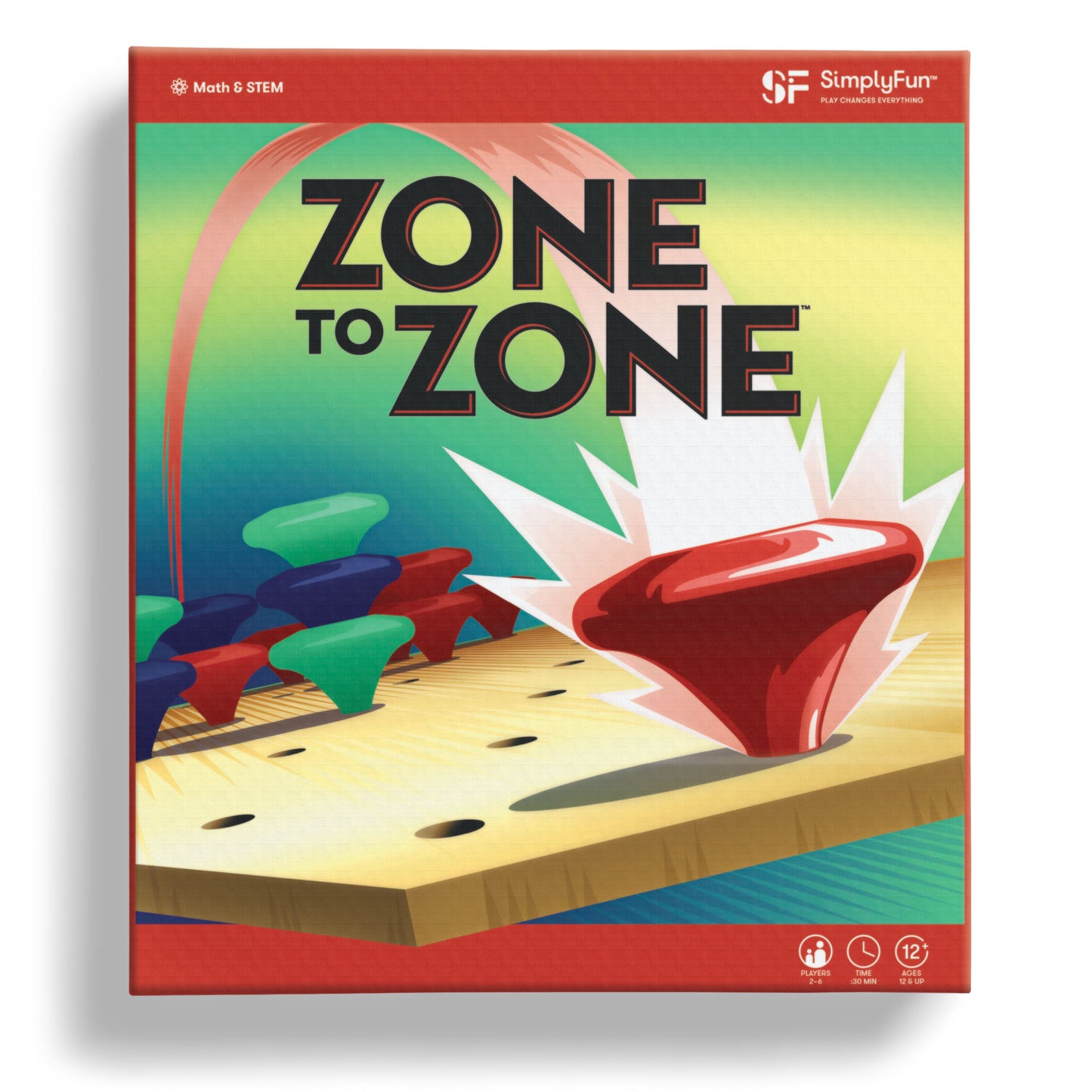
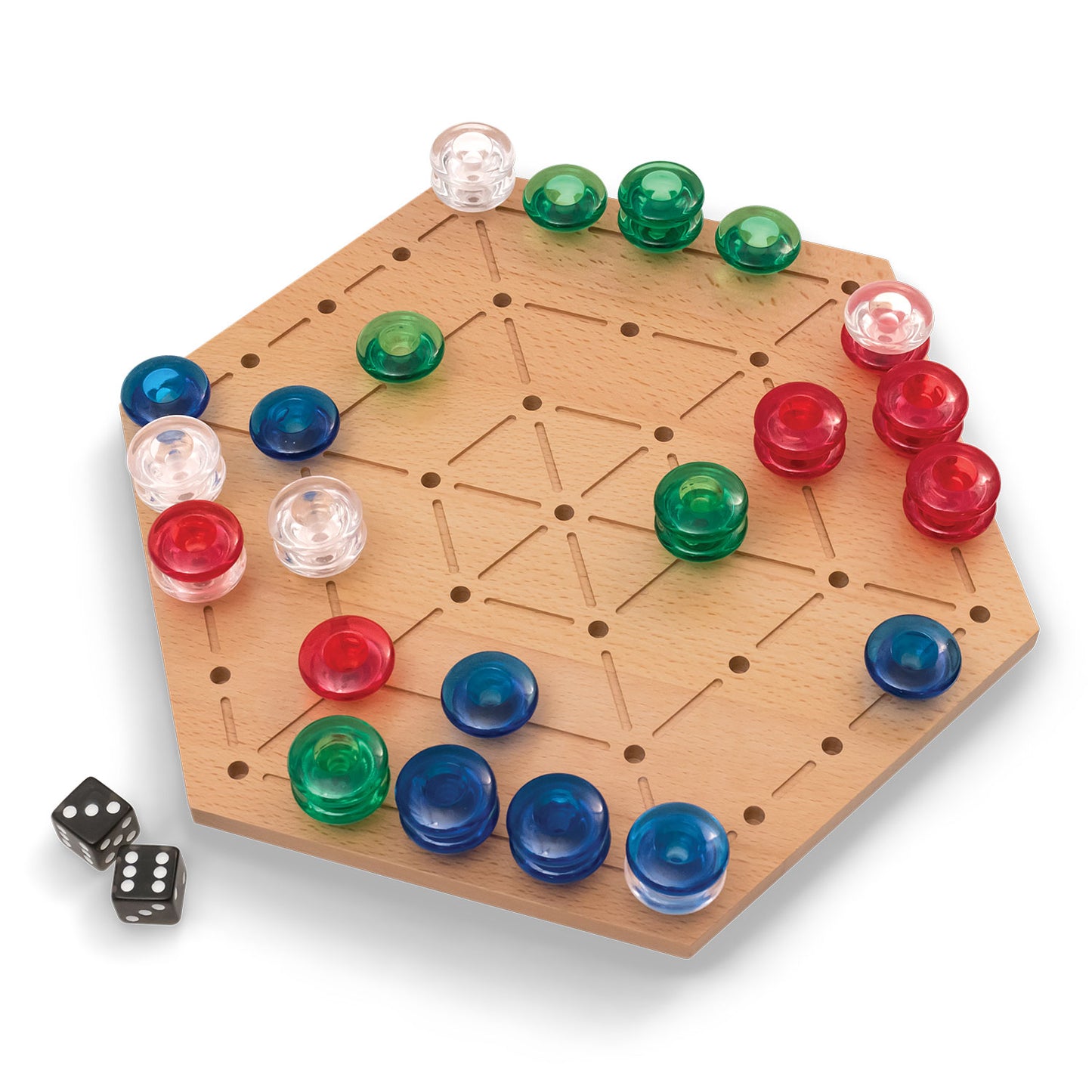
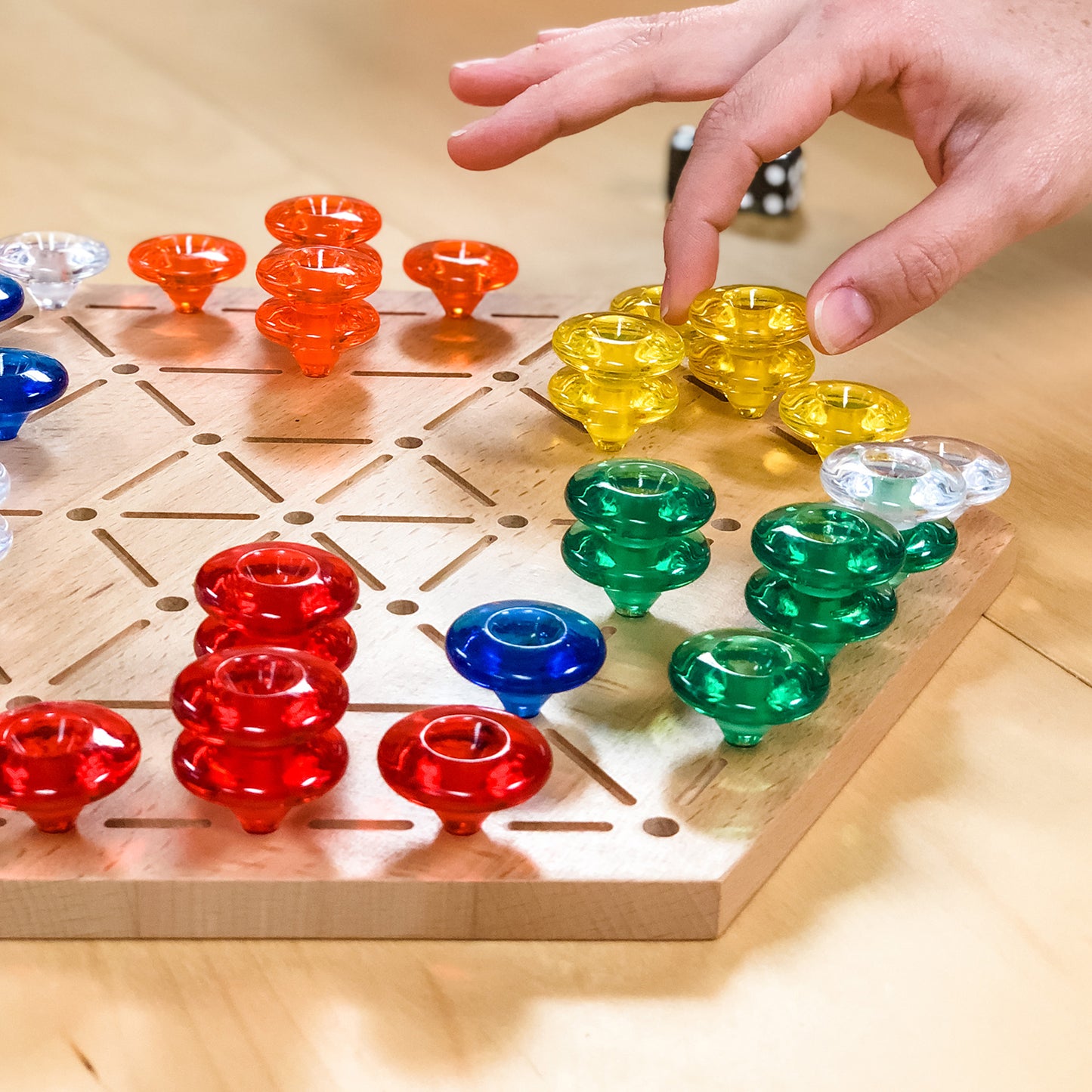
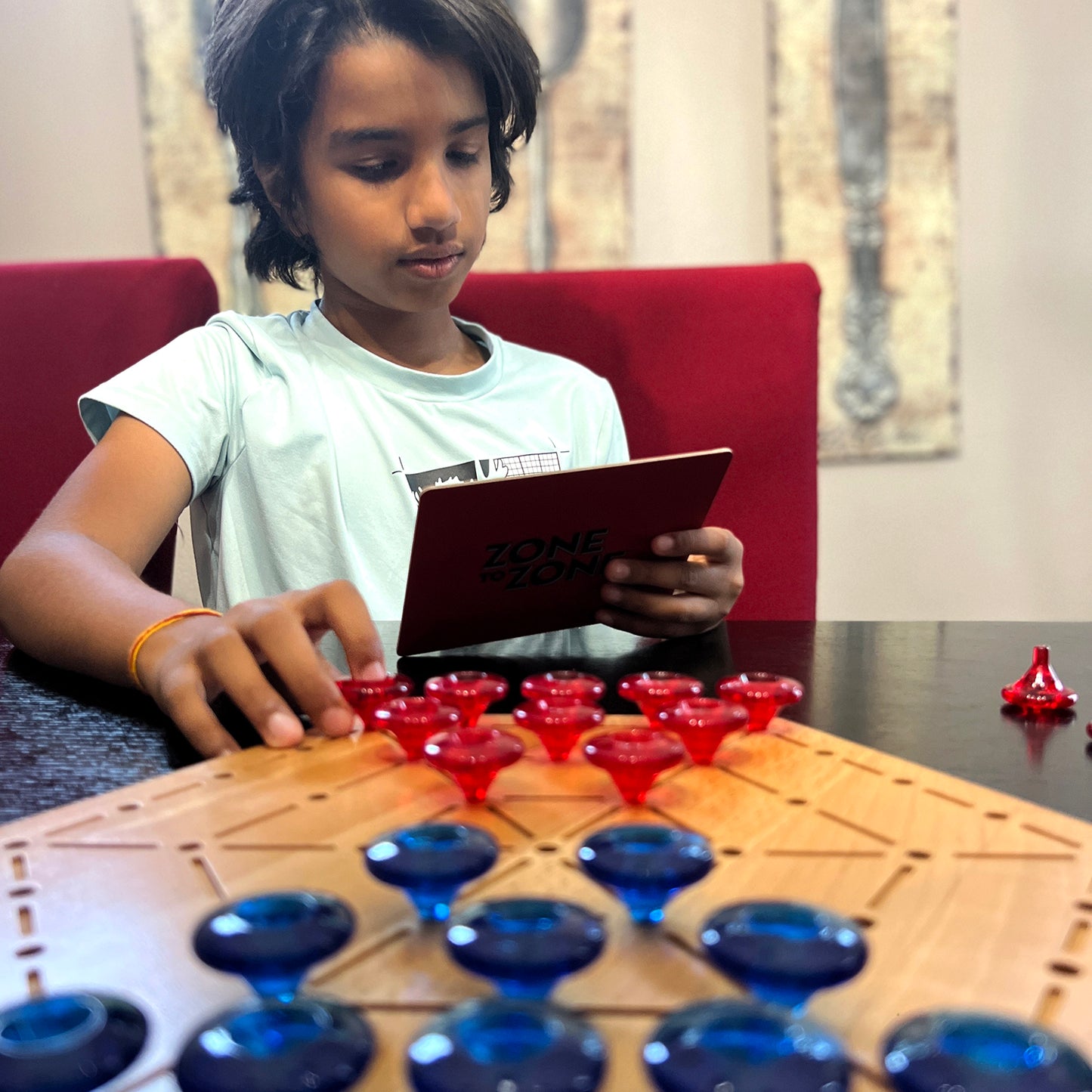
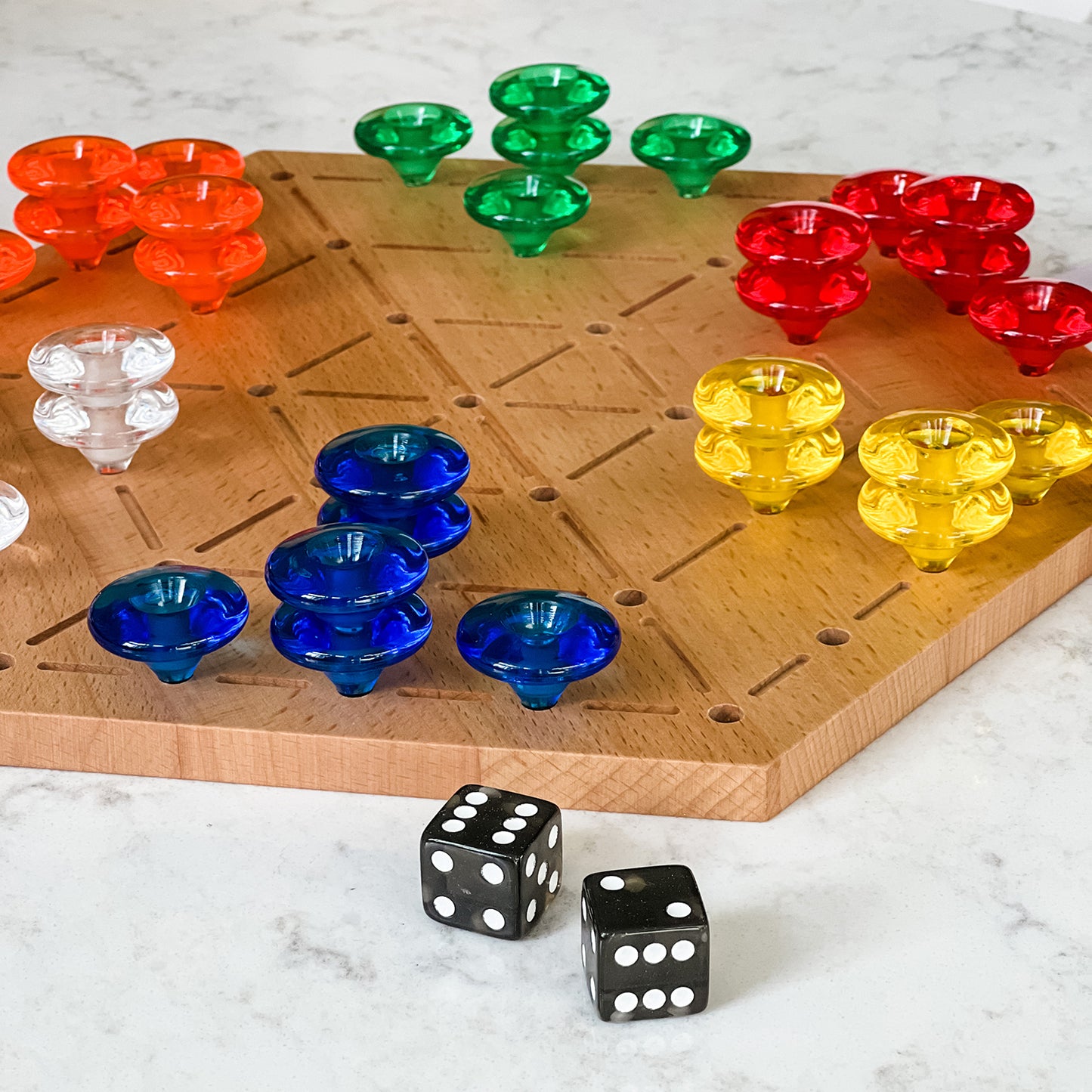
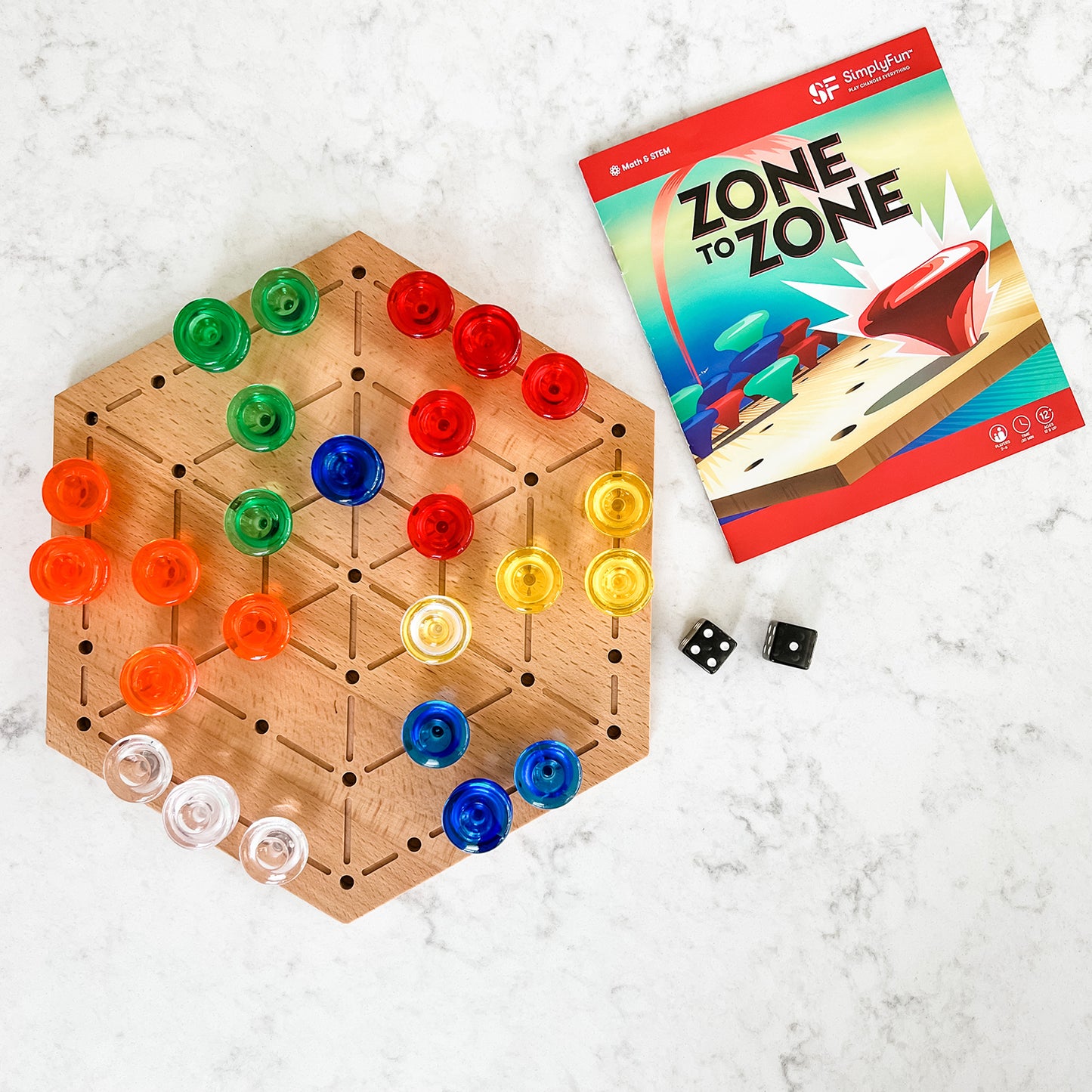
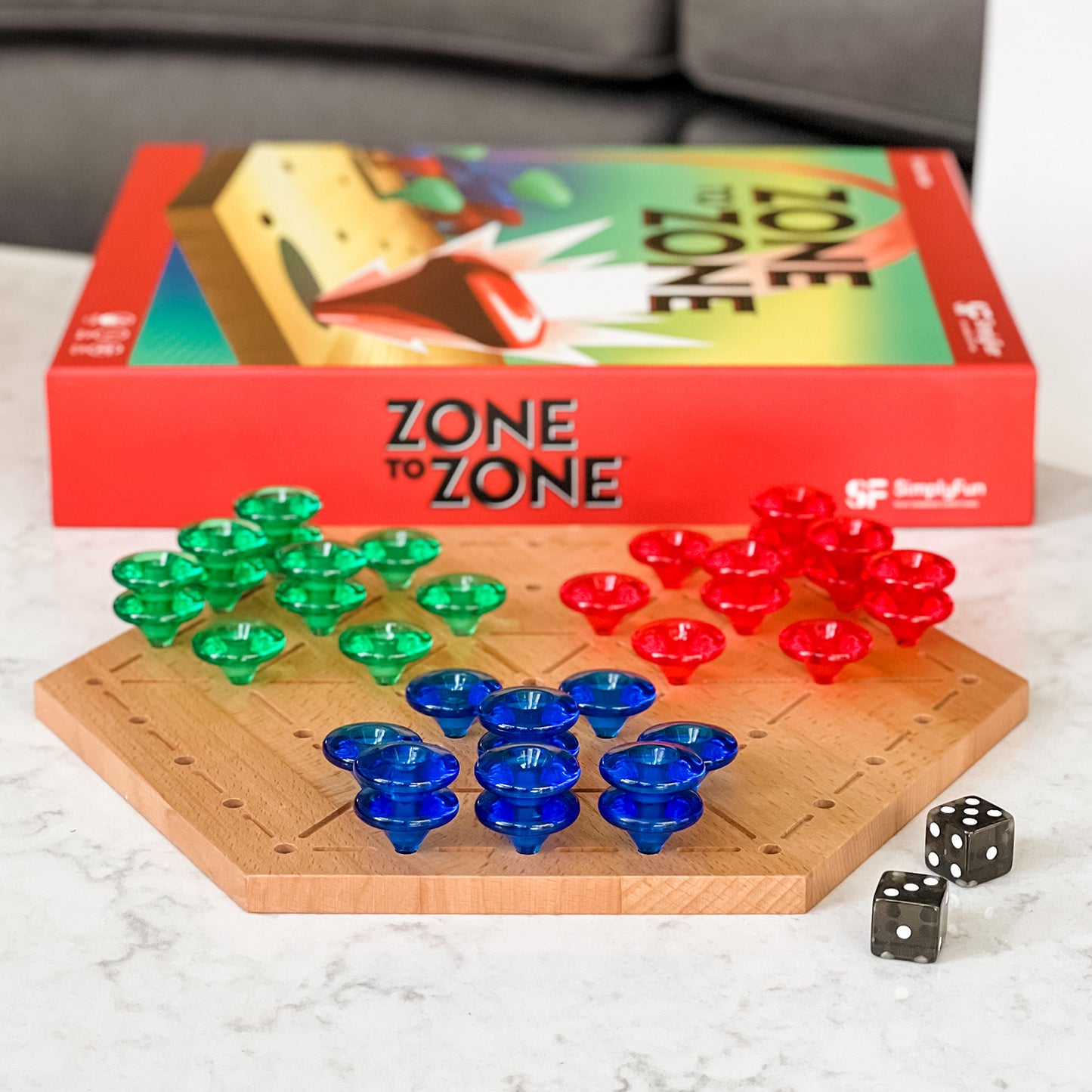

Collapsible content
A high strategy game where players try to be the first to move their pieces across the board into their target zone.
You can play Zone to Zone with 2-6 players, ages 12 and up.
Zone to Zone helps develop Spatial Reasoning skills as players envision the different movement options and how they affect all the pieces on the board as they progress toward their target zone.
Zone to Zone also helps with Probability skills as players choose which of their pieces to move based on their chances of advancing into their target zone or blocking an opponent.
The starting position setup changes according to the number of players. Refer to the rules for setup options.
For a four-player game each player takes 9 pieces in the available color of their choice, and places them on the gameboard like this.
Players take turns rolling the dice and moving their pieces into their target zone, while also trying to block their opponents from doing the same. The first player to get more than half of their pieces to the opposite side of the board, in any of the same positions as they started in, wins the game!
1. Moving Your Pieces
On your turn roll both dice. Each die represents a separate move option. You may choose the order in which you want to use the dice roll. You may only move along the lines etched into the board and cannot change directions within a single move. You may not go forward and back and you may not transition from lines to rings (or vice versa) unless your piece has stopped at an intersection first.
Count every space, including those occupied by other pieces.
For example, if you roll a three and a five, you can move one piece three spaces and another piece five spaces.
Or you can move one piece three spaces and then five more spaces. If you are moving the same piece you may only change direction between the moves for each die.
You must move the full amount of both dice on your turn. Any of your pieces can be moved as long as they are not trapped or prevented by a barrier.
In the rare instance that there is no way to complete both moves, you miss a turn.
2. Barriers
A barrier is created by any three pieces that are stacked together. You may not place a fourth piece on top, and you may not move past a barrier.
Barriers apply to all players.
Use the Legend card as a quick reminder for traps and barriers.
3. Trapping
You may place your piece on top of a single piece or two different colored pieces to trap them. The piece or pieces underneath cannot move until the trap is removed or changed.
Two pieces of the same color stacked in one position create a pair. Pairs cannot be trapped, meaning a third piece of another color cannot be placed on top.
A pair is not considered a barrier and may be passed.
You can trap a single piece of one color with a pair of your own.
How to Free a Trapped Piece
On your turn, if you are involved in a trap (as the trapped or the trapping player) you may roll the dice and instead of making a move, change one trap by switching the order in which the pieces are stacked. Your turn then ends without moving any pieces unless you have rolled doubles, in which case you may roll again and make a move (or change another trap).
If your piece is trapped by a pair, then it can only be untrapped by rolling doubles. Pairs may not be trapped, so the piece that you untrapped must be moved with your next roll of the dice.
If you are prevented from moving due to barriers or a pair you cannot stack on top of, then the piece must be moved at the next available opportunity.
An opponent can also choose to untrap your piece by placing their own piece on the bottom of the stack. If the opponent uses their doubles roll to untrap you from under a pair, you are forced to move that piece with your next turn (or next available opportunity) because pairs may not be trapped.
4. Rolling Doubles
If you roll doubles, you get to take your normal turn and then roll again.
You may also use doubles to untrap one of your pieces and then roll again. If your luck lasts, there is no limit to the number of doubles you can roll and play during your turn.
5. The Center Position
Only one piece may occupy the center position at any given time. This includes pieces of the same color.
A piece in the center position gains two unique movement options:
Option 1, the piece in the center can move immediately to any other position on the board, provided it is not occupied by a barrier or a pair. Using this option, it is possible to use one die to land on the center, move to any position, then use your other die to move to the center with another piece.
Option 2, the piece can be left in the center for one full round. This prevents other players from occupying the center position. After you complete your next turn, including any extra moves earned by rolling doubles, the piece must be moved to any available new position.
The first player to get more than half, in this case 5, of their starting pieces to the opposite side of the board, in any of the same positions as they started in, wins the game!


Core Standard* Math
Math
- Mathematical Practice
- Make sense of problems and persevere in solving them. Grade Level 7
- Reason abstractly and quantitatively. Grade Level 7
- Attend to precision. Grade Level 7
- Look for and make use of structure. Grade Level 7
- Look for and express regularity in repeated reasoning. Grade Level 7


Explore
What Does Child Do To Use Skill In The Game?
While review is not required, players will often reflect back on choices they made.
How Parents Can Assist Learning
Parents can support children by encouraging them to look at all of the pieces on the board. Where are they located? How are they stacked? What are the effects of the stacks?
Learning Implications and Educator Support
Playing Zone to Zone helps children develop spatial reasoning skills, planning, strategic thinking, probability and perspective changing.
Educators can support children by encouraging them to look carefully at all of the pieces on the board and how pieces are stacked, not just their own color.
Determine
What Does Child Do To Use Skill In The Game?
Zone to Zone requires a high level of determining as players examine the board and arrangement of pieces in order to decide what possible moves they can make.
How Parents Can Assist Learning
This game involves examining the board and creating mental models of the consequences of moving different pieces.
When first learning to play, players may think about consequences of the immediate move. As they become more proficient, children will think about multiple moves ahead in order to evaluate what piece would be best to move on their turn. Additionally, there are some instances where a player must move a piece based on what they did in a prior turn. Therefore, they must think carefully prior to moving or untrapping a piece.
Learning Implications and Educator Support
Like chess, Zone to Zone involves examining the board and creating mental models of the consequences of moving different pieces.
When first learning to play, players may think about consequences of the immediate move. As they become more proficient, children will think about multiple moves ahead in order to evaluate what piece would be best to move on their turn. Additionally, there are some instances where a player must move a piece based on what they did in a prior turn. Therefore, they must think carefully prior to moving or untrapping a piece.
In addition to determining how to move pieces, children need to determine what type of strategic approach (offensive, defensive or both) to use during the game. Educators can encourage children to discuss their options and to declare whether they want to make an offensive move (ex: move a piece into their target zone) or defensive move (ex: stack a piece to trap another player in a Pair on Top Barrier) prior to actually moving pieces.
Compare
What Does Child Do To Use Skill In The Game?
Like the Determine skill, Zone to Zone requires a high level of comparing. Players will create mental models of the outcomes for moving different pieces. Based on those models, they will compare to determine the best move.
How Parents Can Assist Learning
To help children evaluate different options, encourage them to "Wait. Look. Think." This will help them spend time considering different moves and the consequences of those moves, which is needed for making higher quality comparisons of options.
This will also help with impulsivity and planning. Using such verbal cues can give children a model for approaching future play.
Learning Implications and Educator Support
Making mental models of a space and movement in Zone to Zone is an advanced, complex cognitive skill that supports learning spatial relations, spatial reasoning, probability, pattern recognition and creative problem solving.
To help children evaluate different options, encourage them to "Wait. Look. Think." This will help them spend time considering different moves and the consequences of those moves, which is needed for making higher quality comparisons of options. This will also help with impulsivity and planning. Using such verbal cues can give children a model for approaching future play.
Remember
What Does Child Do To Use Skill In The Game?
Players may remember moves from prior games that were successful or not; and they must remember whether they freed a trapped piece because that piece must be moved on the next turn.
How Parents Can Assist Learning
In general, adults can remind children of similar situations from prior games and what happened when a player moved a particular piece.
If a player forgets that they freed a trapped piece on a prior turn, it is likely they other players will remind them.
Learning Implications and Educator Support
Zone to Zone is not a memory game. Rather, children may recall prior moves from other games in order to make better choices in the current game. Educators can remind children of similar situations from prior games and what happened when a player moved a particular piece.
If a player forgets that they freed a trapped piece on a prior turn, it is likely they other players will remind them.
Predict
What Does Child Do To Use Skill In The Game?
Prediction is essential to Zone to Zone as players are consistently thinking about what their opponents might do in response to their move.
How Parents Can Assist Learning
To help children predict, ask them to share different moves they are considering and where they think an opponent might move in response. Alternatively, ask them to think about what their opponent might move next. This requires playing non-competitively for the purpose of learning.
Learning Implications and Educator Support
Zone to Zone is great for developing prediction skills. Predicting involves cognitive skills like analysis, observation and interpretation, along with emotional skills like empathy and adaptability. Also, children need to learn how to change perspective, imagining being their opponent, in order to have optimal predicting skills.
Educators can prompt children to practice predicting by asking them to share what opportunities they see on the board, different moves they are considering and what they think an opponent might move on their next turn. This requires playing non-competitively for the purpose of learning.
Plan
What Does Child Do To Use Skill In The Game?
Like prediction, planning is essential to Zone to Zone as players think about future moves and how to make choices on their current turn that help advance their strategy on future turns.
How Parents Can Assist Learning
To help children plan their next move(s) encourage them to "Wait. Look. Think." This will help them spend time considering different moves and the consequences of those moves, which is needed for making comparisons of move options. This will also help with impulsivity and planning. Using such verbal cues can give children a model for approaching future play.
Learning Implications and Educator Support
Planning is an important skill for developing strategic thinking, persistence and reaching a goal.
When learning to play the game, encourage children to discuss the possible effects of different moves. Will they try to trap a piece, remove a trap, create barriers, move pieces around the game board, and so on? There are many options, and discussing with others will help strengthen planning skills as children discuss and decide on best options.
Experiment
What Does Child Do To Use Skill In The Game?
Players may experiment with different offensive and defensive approaches to winning the game.
How Parents Can Assist Learning
Zone to Zone is good for experimenting with strategy and tactics. Discuss different strategies prior to starting the game and encourage the child to select one. Play the game and discuss. Then, play again with the child trying a different strategy. Discuss again and compare the advantages and disadvantages.
Learning Implications and Educator Support
Zone to Zone is good for experimenting with strategy and tactics. Discuss different strategies prior to starting the game and encourage the child to select one. Play the game and discuss. Then, play again with the child trying a different strategy. Discuss again and compare the advantages and disadvantages.
Practice
What Does Child Do To Use Skill In The Game?
While there are not explicit levels in the game, players will increase mastery and proficiency as they play Zone to Zone
How Parents Can Assist Learning
Like chess or a yo-yo, Zone to Zone has numerous implicit levels of mastery with almost no upper limit on the sophistication of playing the game. Therefore, the more children play the more capable they will be in developing and executing increasingly sophisticated strategies. Also, as they become proficient, they will be able to teach others. Teaching others demonstrates mastery, the final stage of learning, and is wonderful for building self-esteem, confidence and intrinsic motivation.
Learning Implications and Educator Support
Like chess or a yo-yo, Zone to Zone has numerous implicit levels of mastery with almost no upper limit on the sophistication of playing the game. Therefore, the more children play the more capable they will be in developing and executing increasingly sophisticated strategies. Also, as they become proficient, they will be able to teach others. Teaching others demonstrates mastery, the final stage of learning, and is wonderful for building self-esteem, confidence and intrinsic motivation.
Solve
What Does Child Do To Use Skill In The Game?
Players solve the game, i.e. win, if they are the first to get a majority of their pieces into the target zone.
How Parents Can Assist Learning
Zone to Zone is great for teaching adaptability and creative-problem solving. Additionally, it involves using visual spatial problem solving, directionality and if/then problem solving. After children have mastered the rules and functions of the pieces, they learn new information constantly during game play. This information directly effects how children strategize an approach for placing and moving pieces, and ultimately solve the game.
This fundamental ability to shift strategies based on new information is a great life skill that can help children cope with the stresses of change in other areas of their life.
Learning Implications and Educator Support
Zone to Zone is great for teaching adaptability and creative-problem solving. Additionally, it involves using visual spatial problem solving, directionality and if/then problem solving. After children have mastered the rules and functions of the pieces, they learn new information constantly during game play. This information directly effects how children strategize an approach for placing and moving pieces, and ultimately solve the game.
Review
What Does Child Do To Use Skill In The Game?
While review is not required, players will often reflect back on choices they made.
How Parents Can Assist Learning
When a child moves a piece and an opponent responds in an unexpected way, ask the child to share how they decided to make their prior move. Help the child examine their thinking, identifying areas where they may be able to consider options and potential consequences more thoroughly on future turns.
Learning Implications and Educator Support
When a child moves a piece and an opponent responds in an unexpected way, ask the child to share how they decided to make their prior move. Help the child examine their thinking, identifying areas where they may be able to consider options and potential consequences more thoroughly on future turns.
Demonstrate
What Does Child Do To Use Skill In The Game?
Players may demonstrate if encouraged. See Implications for Learning and Adult Support.
How Parents Can Assist Learning
During or after the game, replay and discuss moves and what worked and did not work as expected. Thinking out loud is a good strategy for parents to use while playing the game. Children can be encouraged to do the same.
Learning Implications and Educator Support
During or after the game, discuss moves and what worked and did not work as expected.
*Data compiled from CCSSI ELA Standards, WA Science Standards, and Washington Social Studies Standards


Cognitive
Suggestions for How to Modify Play Experience
Play with 2 or 4 players. Use 8 pieces for each player. Players try to be the first to move their pieces to the opposite side. Dice can be used as in the regular game, withtwo pieces individually being moved for the number on die, or one piece being moved the total of both dice. Players can move pieces any direction on the lines. They can jump any piece, counting the jump as part of the number on the die. Players pieces must end in the same positions as they started, just on the opposite side of the board.
Communication
Suggestions for How to Modify Play Experience
Communication is not needed to play, but should be encouraged. Players can discuss why they moved a certain direction or question whether there was a better move.
Sensorimotor
Suggestions for How to Modify Play Experience
Fine motor skills are needed to move the pieces and to stack them on each other. The pieces are large, however, so minor fine motor problems should not interfere with the game.
If a player has more severe fine motor concerns, play as partners with a child who does not have fine motor concerns. Each can then contribute to the decision making about moves.
Social Emotional/Behavioral
Suggestions for How to Modify Play Experience
Zone to Zone requires concentration and focus, so may be a difficult game for children with attention issues.
Zone to Zone is challenging, so children who have impulse control or behavioral issues may find the game frustrating or overwhelming. Encourage the player to describe the options they're thinking about and let the other players contribute to the decision. This will reduce the stress from having to make too many decisions at once.
Let the other players come up with different moves for the child with emotional concerns. The child with emotional concerns then decides which move to make. This reduces the stress, but also allows the child to feel in control.
Vision
Suggestions for How to Modify Play Experience
If children have color blindness, make sure they can differentiate the colors of the pieces before playing.
Hearing
Suggestions for How to Modify Play Experience
Hearing should not be an issue if the player can read the directions.
Have all the players learn some signs they can use in the game, such as: "Good move." "Are you kidding me?" "You're beating me." "Take that!"
*Data compiled from CCSSI ELA Standards, WA Science Standards, and Washington Social Studies Standards


Autism Strengths & Interests
Short Summary of Strengths & Interests
- Strategic thinking
- Spatial reasoning
- Probability
Is good at matching visual items
Is This Game Appropriate? No
Description
Visual matching is not needed in the game, but in order to establish the meaning of each stack of pieces players create, players have to match pictures in the rules to the stacks on the board when first learning the game.
Has a good memory for sensory details, including visual, touch, taste and smell
This game is not appropriate.
Has a good memory for words, phrases and dialouge
This game is not appropriate.
Has a good memory for pictures, numbers and patterns
Is This Game Appropriate? Yes
Description
Zone to Zone is a great game for children torecognize and learn patterns, and use those to make better decisions. Players need to anticipate how movements of individual pieces will lead to advancing toward a goal or blocking other players. They need to follow patterns or create sequences on the board with one or both dice. They also need to anticipate the play of other players.
Likes to put things in order or a sequence
Is This Game Appropriate? Yes
Description
In order to get all of their pieces to their target zone, each player must make a plan for movement of their pieces with each turn. They must plan a sequence of plays depending on the numbers on the dice.
Learns through visualizing or "replaying" actions in their mind
Is This Game Appropriate? Yes
Description
Players will begin to remember previous plays that resulted in successful outcomes by replaying them in their mind. Players can visualize the outcomes of moving their pieces in different directions in order to determine what is the best move to make.
Likes activities with rules, such as math and phonics
Is This Game Appropriate? Yes
Description
Zone to Zone has a many rules relating to the movement of pieces. The rules describe the meaning related to various patterns of stacks of pieces, in addition to the ways pieces can moved on the board. Children with a high level of visual spatial reasoning will enjoy these rules.
Is very concrete and literal
Is This Game Appropriate? Yes
Description
Zone to Zone requires abstract reasoning about the meaning of different colored stacks of pieces.
Learns in small "chunks" (for example, phone numbers are 3 chunks of number xxx-xxx-xxxx that are combined together)
This game is not appropriate.
Is good at nonverbal reasoning and logic
Is This Game Appropriate? Yes
Description
Zone to Zone is a nonverbal reasoning game requiring players to think about optional paths on the board, as well as how to manuever pieces to advance toward a goal or block other players. Players who are good at nonverbal reasoning may enjoy this game.
Likes spatial problem solving
Is This Game Appropriate? Yes
Description
Like chess, Zone to Zone is an advanced spatial reasoning and problem solving game.
Can read well with good vocabulary, though may not fully comprehend content
Is This Game Appropriate? No
Description
Reading is not part of the actual game, and as long as someone can verbally explain and demonstrate the rules of the game, players do not need to read the rules.
Likes to use and has good fine motor skill
Is This Game Appropriate? Yes
Description
Fine motor skills are needed to stack pieces on top of each other and move across the board.
Likes established routines or set ways of doing things
Is This Game Appropriate? No
Description
Zone to Zone will be different with each round of play. Players need to be flexible to be able to modify their play depending on other players moves. This game is not appropriate.
Likes manipulating, constructing or building things
This game is not appropriate.
Likes to use and has good musical abilities
This game is not appropriate.
Likes to use and has good drawing skills
This game is not appropriate.
Autism Special Considerations
Appears to ignore other's communication and/or has difficulty giving eye contact to a communication partner
Is This Game Appropriate for Child with Characteristic? Yes
Can Child with Characteristic Play Game w/o Modification? Yes
Strategies for Developing Compensatory Skills:
Players do not need to talk in order to play Zone to Zone. However, most players will want to discuss (or complain) about the moves made on the board.
Has difficulty understanding complex verbal directions
Is This Game Appropriate for Child with Characteristic? No
Can Child with Characteristic Play Game w/o Modification? No
Strategies for Developing Compensatory Skills:
Zone to Zone has complicated directions, although a visual guide is provided to help players remember the meaning of various stacked piece combinations. Players also need to understand the two path options available to them and understand where they cannot move.
Uses vocabulary inaccurately or demonstrates echolalia (repeating another's speech)
Is This Game Appropriate for Child with Characteristic? No
Can Child with Characteristic Play Game w/o Modification? No
Strategies for Developing Compensatory Skills:
Zone to Zone requires focused attention, so echolalia or unrelated talk will likely be distracting and interfere with the game.
Gets stuck repeating a verbal topic or physical actions and/or has difficulty attending to others' actions or topic.
Is This Game Appropriate for Child with Characteristic? Yes
Can Child with Characteristic Play Game w/o Modification? Yes
Strategies for Developing Compensatory Skills:
Zone to Zone is best when players pay attention to all moves. Each time a player makes a move, the board changes. Players need to be aware of the changing options that arise with each player's moves. Sometimes a planned move will be blocked or a new path will open. It is possible, however, for a player who is distracted to come back from a distraction, refocus, and quickly analyze the board.
Has difficulty producing speech/communication
Is This Game Appropriate for Child with Characteristic? Yes
Can Child with Characteristic Play Game w/o Modification? Yes
Strategies for Developing Compensatory Skills:
Speech and communication with other players is not needed to play Zone to Zone.
Has difficulty sequencing multi-step actions and/or doing complex abstract tasks
Is This Game Appropriate for Child with Characteristic? No
Can Child with Characteristic Play Game w/o Modification? No
Strategies for Developing Compensatory Skills:
Zone to Zone requires a high level of nonverbal, visual spatial reasoning. After rolling two dice, players have to decide whether to move one piece a total of both dice or separate the numbers on the dice to move two different pieces. This requires players to be able to mentally explore options about which moves would be most beneficial. Players also have to make decisions about whether to create blocks to other players moves, to use a turn to untrap themselves, and how to use the special center space.
Demonstrates difficulty initiating and maintaining social interactions
Is This Game Appropriate for Child with Characteristic? Yes
Can Child with Characteristic Play Game w/o Modification? Yes
Strategies for Developing Compensatory Skills:
Social interaction is not needed to play the game, but players must pay attention to other players' moves.
Acts out or demonstrates avoidance behaviors when frustrated, overwhelmed, or needs more sensory input.
Is This Game Appropriate for Child with Characteristic? No
Can Child with Characteristic Play Game w/o Modification? No
Strategies for Developing Compensatory Skills:
Because of the difficulty level of the game, players may become frustrated when their plan for a move is blocked. The level of attention required may also be hard for some children to maintain, particularly those who need a variety of sensory input to help them maintain attention.
Has short attention span for non-preferred activities
Is This Game Appropriate for Child with Characteristic? No
Can Child with Characteristic Play Game w/o Modification? No
Strategies for Developing Compensatory Skills:
Unless challenging visual spatial reasoning games are a preference, Zone to Zone may not be a good match. The game requires intense concentration on multiple aspects at one time.
Needs sameness or consistent routines and/or has difficulty with transitions from one activity to another
Is This Game Appropriate for Child with Characteristic? No
Can Child with Characteristic Play Game w/o Modification? No
Strategies for Developing Compensatory Skills:
Like chess, the rules to Zone to Zone stay the same with each round of play, but the game itself changes with each turn. Children who require sameness will likely find this game to overwhelming.
Has difficulty understanding others' feelings, intentions, and the reasons for others' actions.
Is This Game Appropriate for Child with Characteristic? No
Can Child with Characteristic Play Game w/o Modification? No
Strategies for Developing Compensatory Skills:
In order to think strategically, players need to be able to analyze the board and anticipate what other players my want to do. This will enable players to create a block for these potential moves.
*Data compiled from CCSSI ELA Standards, WA Science Standards, and Washington Social Studies Standards


- Choosing a selection results in a full page refresh.
- Opens in a new window.









